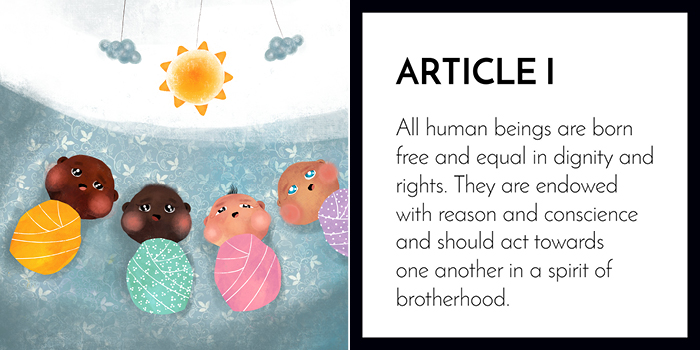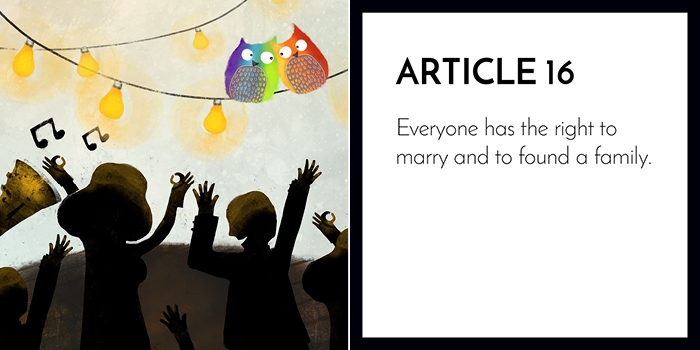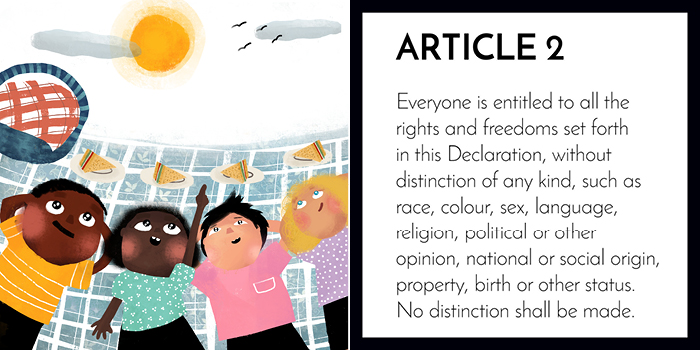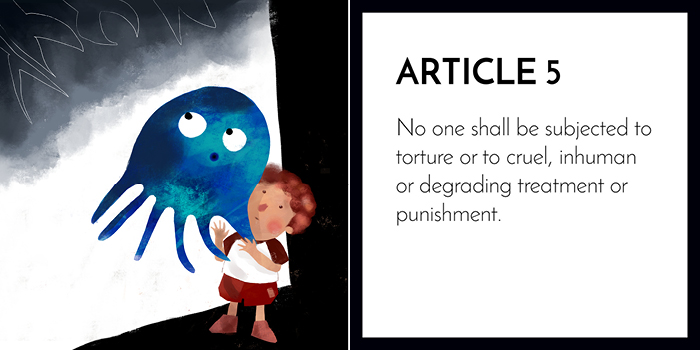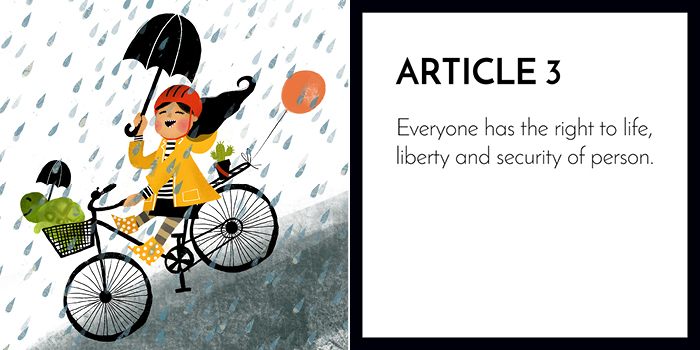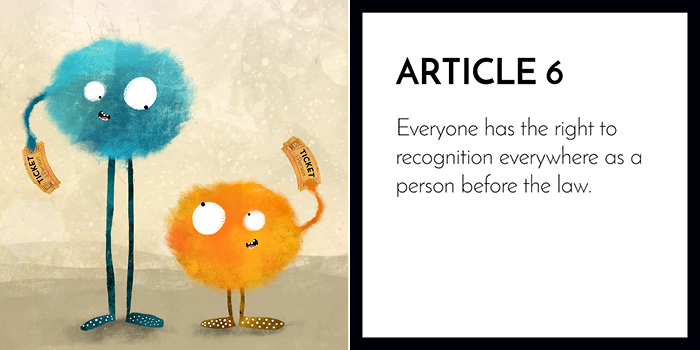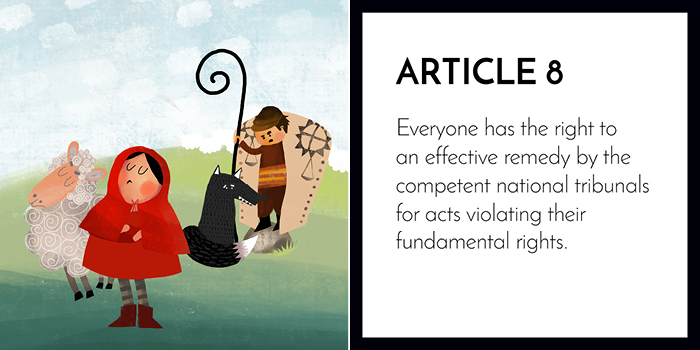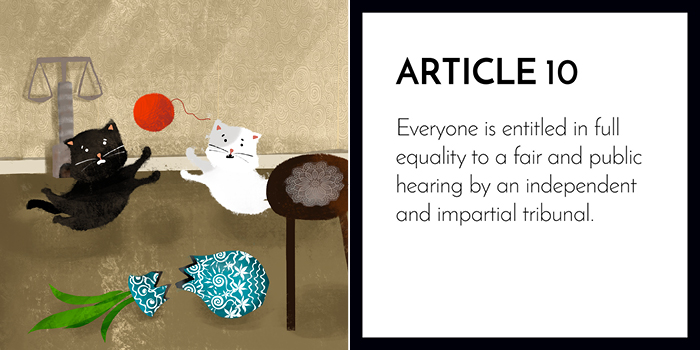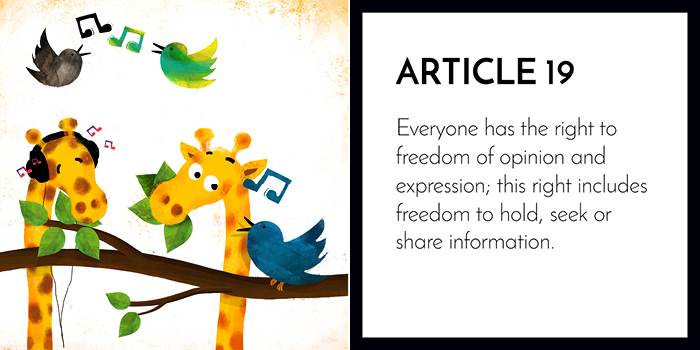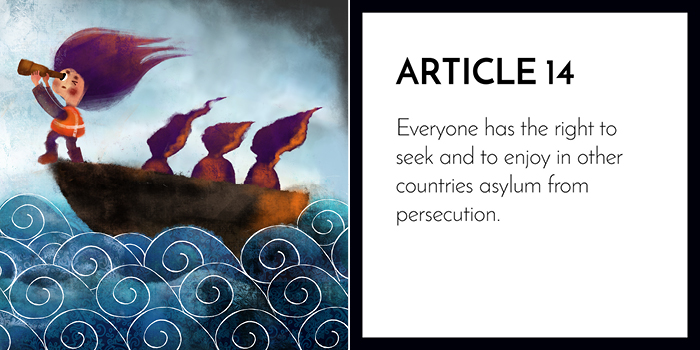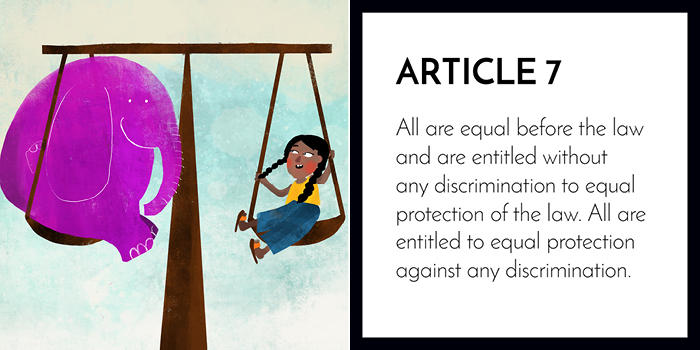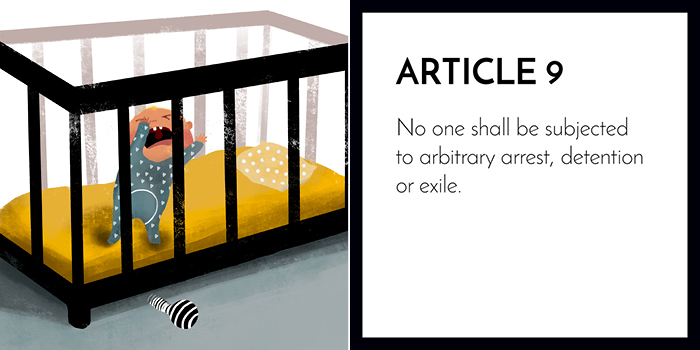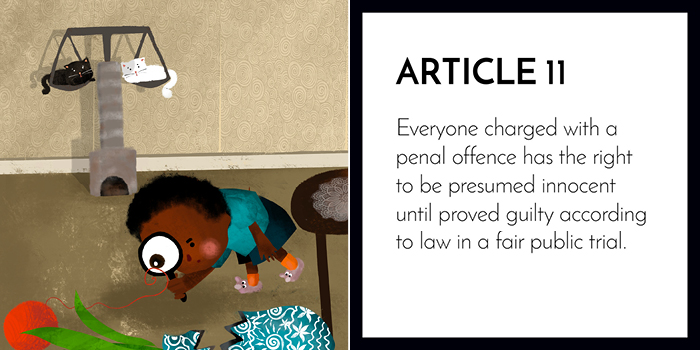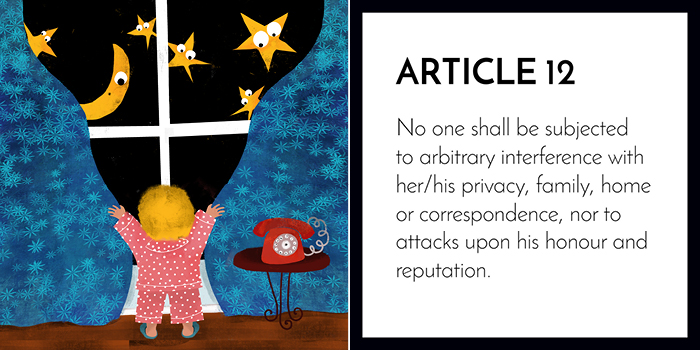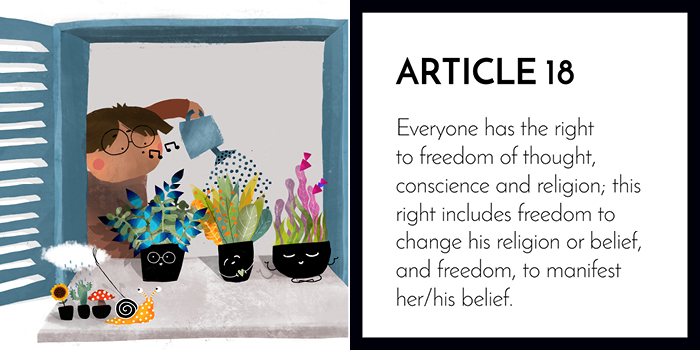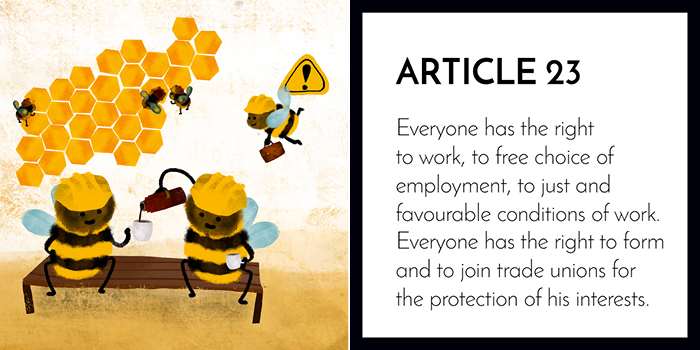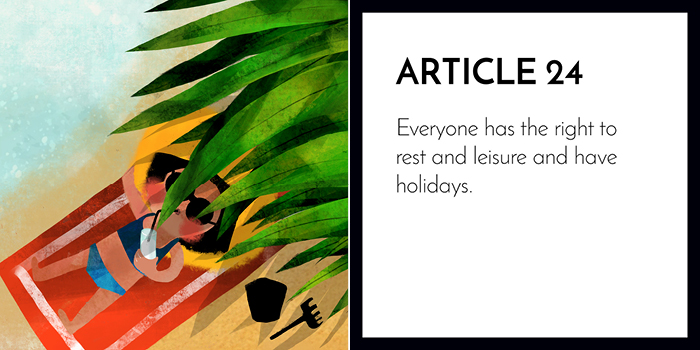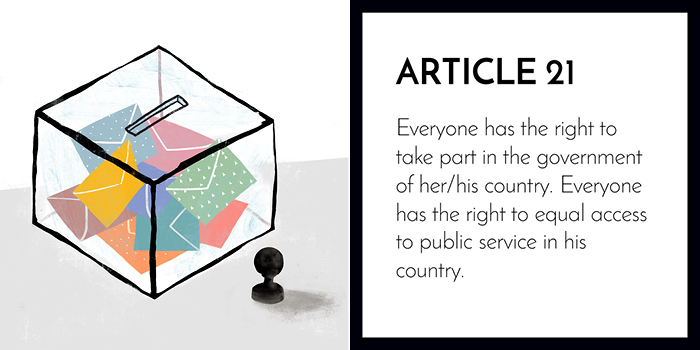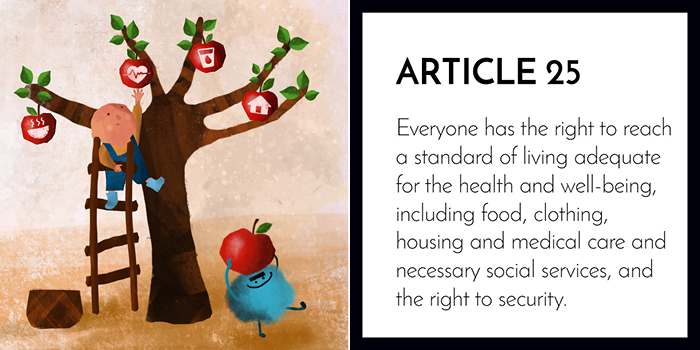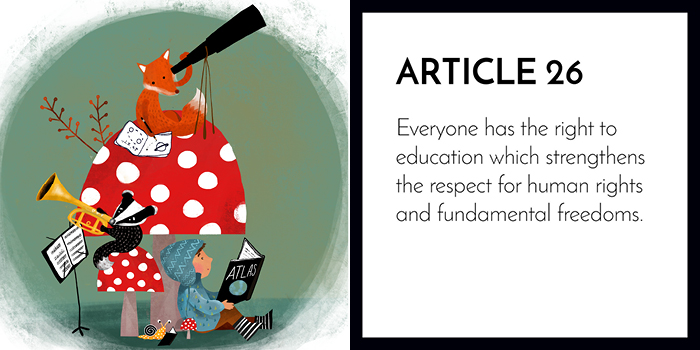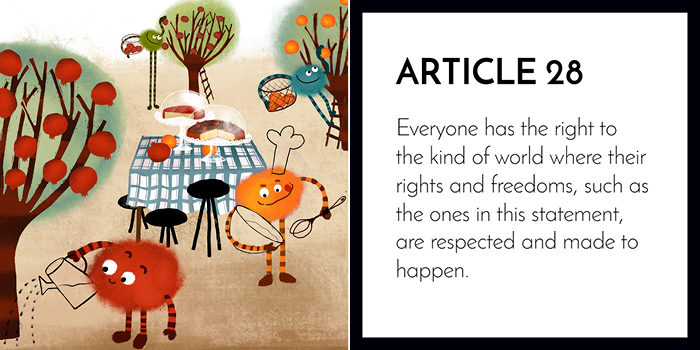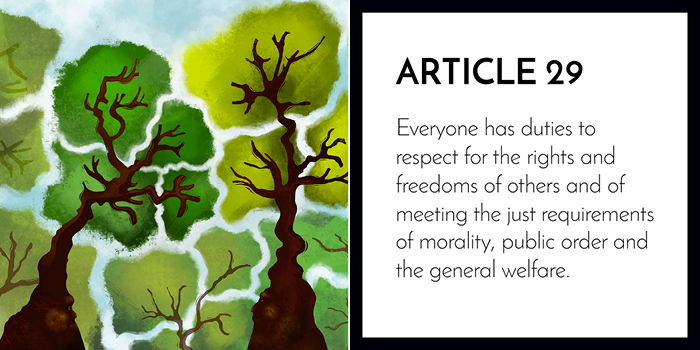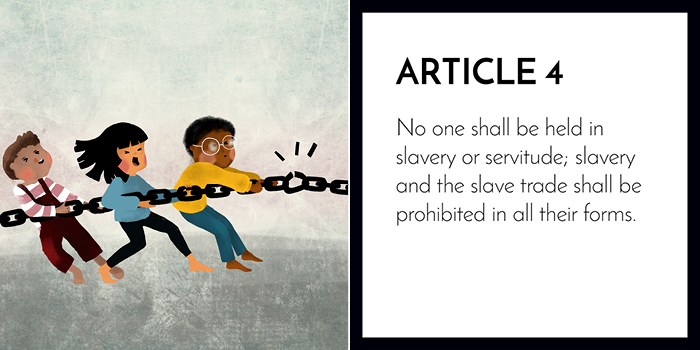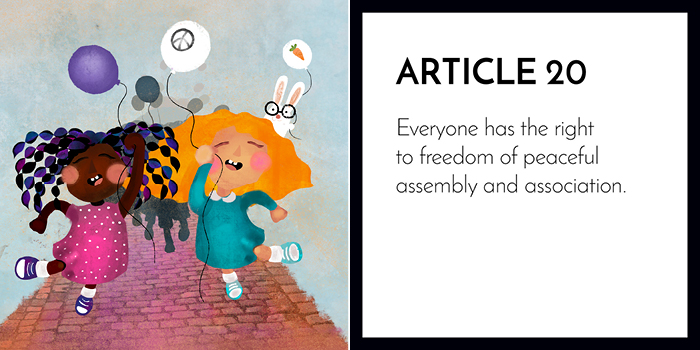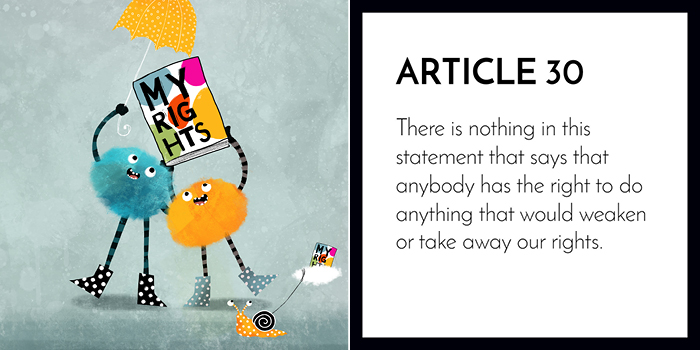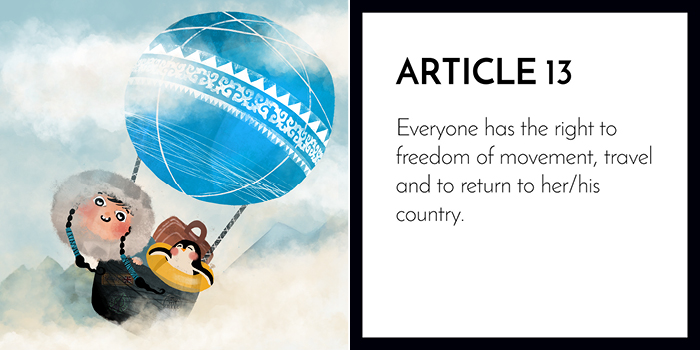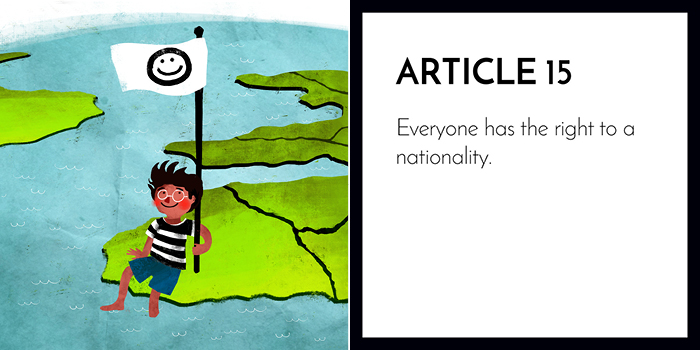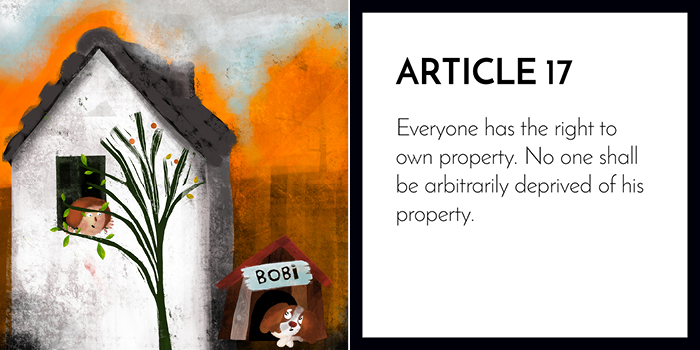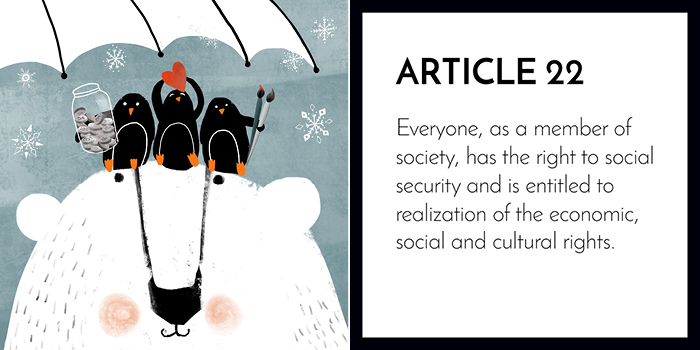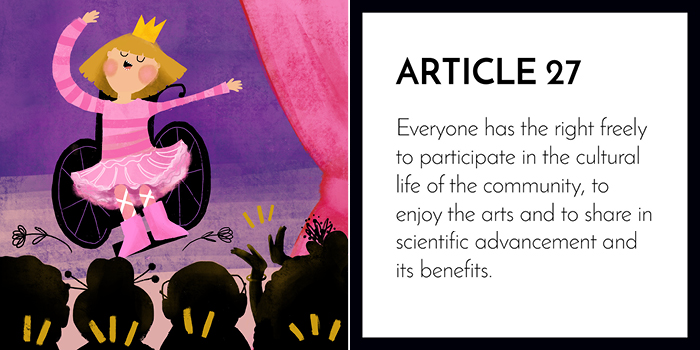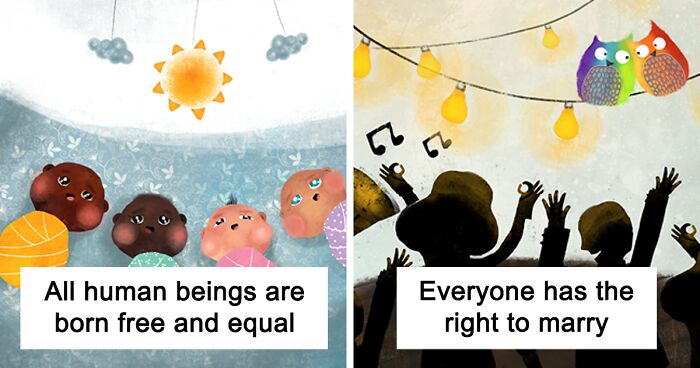
4Kviews
Turkish Artist Introduces Children To Human Rights Through An Interactive Card Game With 30 Illustrations
A Turkish illustrator illustrates all 30 articles in the Universal Declaration of Human Rights to create a card game for children for Amnesty International. Ozge Tigli created an imaginary world and illustrated human rights connected with the children’s world, even the ones about slavery, torture, and law.
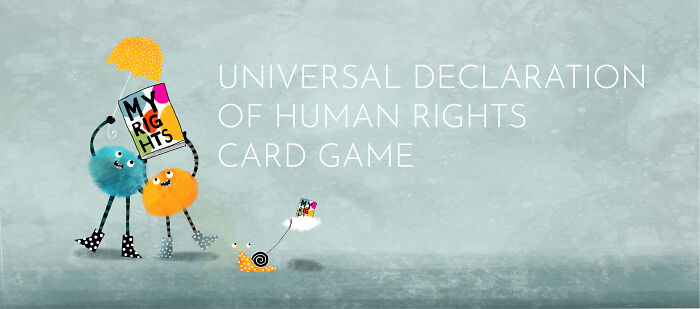
More info: twitter.com | Instagram
This post may include affiliate links.
Article 1: All Human Beings Are Born Free And Equal
“This card shows how everyone born under the sky and sun is born free and equal.”
It shows how all humans have rights since the day we were born, which directly connects to Article 1. In this illustration, it was important not to arrange the newborns according to their skin tone, such as dark-skinned, brown, and white—to show that we should not separate people by race.
if everyone was born with the same physical characteristics, the humanity woud find a new way to racism.
There is a sense of urgency in teaching the new generation’s children about their and others’ human rights. In a world where learning has become instantaneous and online, we need to find more methods to teach children in interactive, fun, and impactful ways. Ozge Tigli has found a way to do this by combining her International Relations and Political Science studies with her skills in illustration. As the creative director of Bumbuku Creatives in Amsterdam, she specializes in digital storytelling and social impact. She cares deeply for children playfully learning about human rights. For this, Tigli created a card game on the 70th anniversary of the Universal Declaration of Human Rights for Amnesty International and illustrated all the rights. In an interview with Tigli, she talks about each card illustration, the ideas behind them, and how important they are for our children.
Article 16: Everyone Has The Right To Marry
This card doesn’t show children in a marriage scene because it is still a huge problem in many countries, including Turkey. You see a wedding or a celebration happening, but don’t really see who is getting married, except some adult silhouettes. The main focus is on the owls at the top who stand side by side, drawn with rainbow colors. This places emphasis on LGTBQI rights, a community that doesn’t yet have the right to marry and start a family in most parts of the world.
“I want an LGBTI child to see this card. Even if they grow up feeling not being accepted, I want them to remember that once an adult thought about them and illustrated such a card to celebrate love. It is one of the seeds that I planted into the cards.”
Article 2: Everyone Is Entitled To All The Rights In This Declaration
This illustration is a continuation of the first card. The newborns are now grown up and are enjoying a picnic, still standing together as equals under the sun. Each child holds a sandwich that is equal in size. You see one of them pointing towards a flock of birds in the sky, which represents freedom.
“Maybe the child associates his friends with those birds, free to fly.”
“Every card tells stories of children and their imaginary friends living in a world shaped by the Universal Declaration of Human Rights. I planted some visual subtext in each card as seeds in the hope they will grow at the right points when they meet a drop of water in the future for each child.”
Article 5: No One Shall Be Subjected To Torture
“I made this card a little dark on purpose to make it easier for children to remember the cards while playing and thinking about the torture.”
Tigli illustrated the feeling of fear to help children develop empathy for victims who have experienced unjust treatment. At the top, you can see historical tools used for torture. But they were drawn in the shape of crab clamps so as not to frighten or traumatize children. The main image shows a kind-hearted creature resembling an octopus that looks like a benevolent friend with a big protective hand over the boy. The card was one of the most challenging to create.
Article 3: Everyone Has The Right To Life, Liberty And Security
You see a girl wearing a helmet and riding freely in the rain. Both she and her tortoise have an umbrella to protect them from the rain. She carries a small cactus on the back of the bike, a seat belt on and a balloon firmly attached to the bike. These two objects have the same rights simultaneously and can live together in harmony without harming each other.
It is played by matching all 30 rights in the Declaration with 30 illustrated cards. Since most Articles in the Declaration are about laws and abstract topics that do not have a place in children’s world, she tried to create each of them in connection to children’s daily practices to help them empathize with the issues easily.
Article 6: Everyone Has The Right To Recognition As A Person
“These two are very close friends. One is long, and one is short, but each counts as one person.”
Both these creatures have a ticket for one person in their hands, finding this both funny and beautiful. What these tickets are is not clear. They may go to the cinema or a carnival. Whatever they do, wherever they go, they will have fun together! They know that their fun will remain half if one of them doesn’t have a ticket for the other. And as long as they are together, both the long and short creatures will remain happy.
Article 8: Everyone Has The Right To An Effective Remedy By Tribunals
The wolf is on trial by the shepherd for violating the sheep’s rights, and Red Riding Hood, who has experienced a similar violation at the hands of the wolf, is also present in the scene. Although the shepherd is a child, he knows the difference between right and wrong.
Tigli links this to history as well. “The patterns on the upper part of the shepherd’s shutter are traditional patterns, while the scales on the lower part are added to represent fair judgment.”
“In order to achieve progress in human rights, we need to accept children as our biggest allies. Let them learn their rights to protect their own and also respect others. Instead of hiding remote concepts like slavery or torture, I needed to find a way to talk about them with children because they live in such a reality. You can find a way to discuss everything with children; just trust in their perception.”
Article 10: Everyone Is Entitled In Full Equality To A Public Hearing
This picture is about a crime: something society faces daily. While playing with a ball of rope, the two cats broke the vase in front of them. The purpose here is to be unsure of whom to blame: the black cat or the white cat? In the background, you see a cat playground that resembles the Scale of Justice, representing judgment. Tigli points out that “the biggest helper of the card is the next card… Since Articles 10 and 11 are connected, I tried to make children interpret the cards more easily by associating both rights.”
Tibby and Sooty, you are charged with the destruction of a vase! How do you plead?
Article 19: Everyone Has The Right To Freedom Of Expression
To express freedom of speech and opinion, birds are shown as symbols connected to Twitter, where there is so much debate on freedom of expression, especially in Turkey. The birds’ shapes are quite similar to the Twitter logo, and the bluebird at the bottom is trying to share information with the giraffes. This way, the giraffes are exercising their right to receive and have access to information. While one giraffe communicates with the bird, the other is happily listening to music on its headphones because it does not wish to listen to their perspectives. On the top, you see birds of different colors singing freely in their own ways. No one in this image is getting angry at each other and is allowing one another to speak their mind freely.
Article 14: Everyone Has The Right To Seek Asylum
“It’s a bit of a sad card, but I’ve painted it this way to help kids empathize with it.”
This card shows a hopeful journey for refugees on the water looking for asylum, showing their quests as something positive. The children at the back are looking at their burning homes. Their fire-like hair represents they are affected and carry the sadness of the events, but the child searching for land looks hopeful and brave. This brave girl is trying to find a solution and a new home for herself and her community to spend their lives in.
I understand the right to seek asylum, but don't the rights to seek and to enjoy contradict each other? Seeking implies the possibility of being turned away, but the "right to enjoy asylum in other countries" implies that countries don't have a right to turn away asylum-seekers.
Article 7: All Are Equal Before The Law
In this card, Tigli tried to sneak abstract concepts into children’s daily practice, like riding a swing, so that they can create some form of connection. The swing represents fairness, law, and justice on which a big purple elephant and a small Bangladeshi or Indian girl sit. It shows that their weight is equal before the law.
Article 9: No One Shall Be Subjected To Arbitrary Arrest
To show the importance of this Article, Tigli attached the concept of imprisonment to children’s daily lives. She didn’t want to portray the action of being in a cot as something negative, which is why there is a fallen toy on the ground that made the baby cry. Instead, the emphasis is on the feeling of being entrapped in situations one does not want to be in.
Article 11: Everyone Has The Right To Be Presumed Innocent
Continuing from Article 10, now you see the child who lives in this house come and examine the crime scene in his rabbit slippers, investigating even the tiniest thread. In the background, both the white and black cat are waiting for the results while sitting on Judgment’s balanced Scale. The child here is a Black boy who represents his community’s suffering by police brutality and prejudices of the American justice system. While his socks are orange, the color of prison, he is not a victim or a prisoner. Instead, he shows a safe space where trials and judgment can take place.
Article 12: No One Shall Be Subjected To Interference With Their Privacy
This illustration shows a scene that may be familiar to children in their daily lives. Tigli explains, “When night falls, the little boy who is preparing to sleep closes his curtains against the curious stars and the moon. He protects the privacy and inviolability of his family, home, and private life.” The phone on the side table reminds us of the importance of the privacy of communication too.
Article 18: Everyone Has The Right To Freedom Of Thought
The purpose here is to show that everyone has a different perspective, even about the same thing. You see the child planting flowers in different pots that represent different thoughts, conscience, and religions. He takes care of all these pots and cherishes them, seeing each plant grow the way it wants to. You see that no flower is like the other. Each is different and makes the world beautiful. You see a small snail happily watering and planting its own pots growing under a cloud filled with rain in the left corner.
“Everyone, young and old, small and big, has their unique and precious perspectives.”
Article 23: Everyone Has The Right To Work
These hard-working bees in a ‘sweet’ environment show how everyone has a right to work and labor protection. Since Tigli didn’t want to draw children and associate them with labor, given that child labor is such a prominent issue in our world, she drew bees, which we all know are hard-working. You see some bees working while others are taking a break and drinking coffee. At the back, there is a bee passing by who could be the manager or a trade unionist to highlight the concept of security. The main message here for children is that the workplace is a friendly and sweet place, just like honey.
using eusocial insects is not the besst example as their system is a caste system (bees, ants termites etc)
Article 24: Everyone Has The Right To Rest
This image is clear in communicating that everyone deserves a holiday. A child is relaxing on a beach under a tree, soaking up the sun, listening to the sea waves, and drinking milk. What else should a holiday look like?
Article 21: Everyone Has The Right To Vote
This card focuses not only on democracy as a form of government but also on the overall idea that everyone in their country should have the right to express their political opinion and participate in public service. Children need to understand this and associate the ballot box with transparent and free elections.
Article 25: Everyone Has The Right To Reach A Standard Of Living
Since this article covers many important concepts, Tigli drew an apple to symbolize basic human needs to make it simple for children. You see images of steaming soup, clean drinking water, home, and medical assistance on these apples. These icons are the same as those found in the UN’s Sustainable Development Goals (SGDs), which are very relevant to connect with. The child in the image reaches for medical assistance, which is strongly emphasized here because this child has no hair, maybe struggling with cancer. The overall feeling is meant to show a healthy lifestyle during a bright apple harvesting time.
Article 26: Everyone Has The Right To Education
This illustration tries to show that everyone in the world has the right to education. By seeing things like books, musical instruments, and a telescope, children will be able to directly connect these objects to the concept of education that is so versatile.
“Children who see, learn and understand other worlds will not be afraid of them and will learn to respect them.”
Article 28: Everyone Has The Right To Live In A World Described In This Statement
This Article talks about social order in some way which this card tries to convey. You see many trees filled with fruit that represent social rights, and you can climb up the stairs to access these rights. “In this system, everyone contributes to the achievement of these rights. Some are watering trees, some collecting fruits, some making delicious tarts and cakes from the collected fruits.”
At the end of the day, there is room for everyone to gain from the harvested fruit but collectively and communally. Everyone has a place: the tall ones have shorter chairs to sit on, and the short ones have taller chairs.
Article 29: Everyone Has The Duty To Respect For The Rights Of Others
In this card, you see two trees. Their bodies resemble faces and their branches represent communication. Tigli borrowed from the ‘shy tree phenomenon’ where trees do not touch each other but form canopies. In this way, the branches and leaves grow together in harmony without interfering with each other. They live side by side for centuries and express themselves by their height, color and density, with hundreds of trees absorbing sunlight and rain through time.
Article 4: No One Shall Be Held In Slavery
This card is about slavery and the fight against it in the past and present. The Black child in front represents his community’s anti-slavery struggles. The two children at the back have experienced slavery in modern times—a Thai girl who is a victim of child sex tourism and a Bangladeshi boy who works in a factory. They are all barefoot because the fight against slavery is difficult and unfair. The other side of the chain shows the collective struggle to escape slavery, but Tigli left it out as she didn’t want children only to see the dark side of slavery but the collective fight against it.
“In my research for the game, I learned the most shocking information from this card. Right now, worldwide, up to 10 million children are trapped in modern forms of slavery.” She is hopeful that one day the chains of slavery will break.
Article 20: Everyone Has The Right To Peaceful Assembly
To show the right to peaceful assembly, the children are demonstrating on the street. Everyone can voice their own concerns. The girl on the right wants peace, and the rabbit behind her wants a carrot. At the same time, the girl on the left is happily joining the cause. Tigli explains that she “deliberately drew both of the children demonstrating on the street as girls for the children to absorb the vision that women can comfortably exist on the streets.”
Article 30: Nobody Can Take These Rights From You
While rights are universal, at the core, they belong to individuals, and this is what the illustration tries to show. No one can take another’s right and no one has to give up their right. You see a little snail at the bottom with a floating cloud to support and carry its rights wherever it goes.
Article 13: Everyone Has The Right To Travel
This card shows freedom and happiness. Here, the girl is on a hot air balloon traveling the world without restrictions. The balloon pattern is inspired by tying styles and prints of nomad tents from Central Asia. Maybe she turned her tent into this balloon. The image shows how traveling to different countries can be such an enriching experience for both individuals and the countries. “Every tourist carries the richness of their own culture and their own originality.”
Article 15: Everyone Has The Right To A Nationality
“One should be content and peaceful from the country of which they are a citizen,” says Tigli. A boy casually sits by the sea with his feet in the water, holding a flag with a smiley face on it. This image may connect to the refugee crisis and show refugees positively, but it is really up to the children how they interpret it.
Article 17: Everyone Has The Right To Own A Property
This card has earthy colors representing the concept of having a home on earth that belongs to you and your family. As we all know, property is a controversial topic. And the concept of ownership might be difficult for a child to grasp. The main character in this image, Bobbi, shows that no one can take his property away from him because he has the universal right to own and live in his home.
Only, in the United States, the government at any level can declare "eminent domain" and take your property away from you.
Article 22: Everyone Is Entitled To Economic, Social And Cultural Rights
Since this Article covers so many themes, Tigli used symbols as clues. The penguin on the left is holding a glass jar full of coins representing economic rights. The middle penguin is holding a heart that represents social rights. The penguin on the left is holding paintbrushes to represent cultural rights. All of them feel secure under a large umbrella and sitting on top of a friendly polar bear, symbolizing social security.
Article 27: Everyone Has The Right To Enjoy Art And Science
You see a young girl with a walking disability performing in a ballet show. Tigli specifically chose to focus on disabled children because they are mostly represented in stories related to disabilities. But here, you see this girl is happy and confident in performing in front of an audience. The audience seems to be enjoying the show—they are applauding and throwing flowers in appreciation and support.
Until people stop saying "I brought you into this world and I can take you out of it" I don´t see a bright future for this kind of game. Parents disown their children for being homosexual, yell at them for bad grades, abuse them for not following all their rules to a T. Sorry about the rain on this parade.
But the rest of us aren't evil. We can show compassion. What are they against us in numbers.
Load More Replies...Awesome, I couldn't help upvoting for another reason (look at my surname... lol)
Until people stop saying "I brought you into this world and I can take you out of it" I don´t see a bright future for this kind of game. Parents disown their children for being homosexual, yell at them for bad grades, abuse them for not following all their rules to a T. Sorry about the rain on this parade.
But the rest of us aren't evil. We can show compassion. What are they against us in numbers.
Load More Replies...Awesome, I couldn't help upvoting for another reason (look at my surname... lol)
